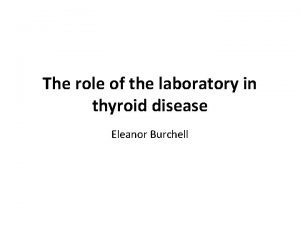Oral Manifestations Of Systemic Disease Sjgrens syndrome nd

- Slides: 1

Oral Manifestations Of Systemic Disease Sjögren's syndrome nd 2 AHMED AWAD EL BEIGO Year Dentistry Faculty Of Basic Medical Science Libyan International Medical University Supervisor: DR. KHADIGA M. MANSUR Introduction : Other causes of xerostomia including drug induced must be excluded, Definite diagnosis by anti-body screening especially rheumatoid factor, SS-A (Ro) and SS-B (La), labial salivary gland biopsy showing periductal lymphocytic infiltrate[1]. Sjögren’s syndrome is a chronic inflammatory autoimmune disease, attacking the salivary and lacrimal glands, it’s characterized by dry mouth ( xerostomia ) and dry eyes ( xerophthalmia ), other organ manifestations may be seen [1] [3]. It can be either primary, or secondary associated with rheumatoid arthritis or other connective tissue disease[1]. It should be differentiated from other causes of xerostomia, and it can only be treated by managing the symptoms [1] [2][3]. Discussion : Sjögren’s syndrome affects females nearly 10 times as frequently as males. Primary sjögren's syndrome cause more severe oral and ocular changes , and it has a higher risk of lymphomatous change than the secondary[1]. Sjögren’s syndrome the histological appearance[1]. Principal of management: reassurance of the patient with symptomatic treatment of the dryness via artificial saliva as well as choline esterase inhibitor drugs, control any associated infection and dental caries. Regular follow up to observe for possible development of lymphoma[1]. 30% of systemic lupus erythematosus patients. Secondary sjögren’s syndrome affects 15% of rheumatoid arthritis patients. Salivary glands are often enlarged as a result of lymphocytic infiltrate , a parotid swelling appearing after years of the onset strongly suggests lymphomatous change[1]. The autoimmune disease results in destruction of salivary glands thus causing xerostomia which in turn, disturb quality of speech, predispose to infections, disturb taste sensation, cause difficulties in eating and swallowing, and increase susceptibility of dental caries[1]. Sjögren’s syndrome can have serious ocular effects including Failure of tear secretion, failure of clearance of foreign particles from cornea and conjunctiva, gritty sensation, inflammation, risk of impairment or loss of sight[1]. Conclusion : • Dentists must be aware that oral diseases may be caused by a systemic disease. • Sjögren’s syndromes mainly result in dry mouth and dry eyes. • Secondary Sjögren’s syndrome is associated with connective tissue disorders. • Differential diagnosis is important excluding other causes of xerostomia, and using anti-body screening and labial salivary gland biopsy. Salivary gland swelling in Sjögren’s syndrome[1] Extraglandular manifestations including synovitis, pulmonary fibrosis and peripheral neuropathy may be seen[3]. . • There is no current cure for the oral manifestations of sjögren’s syndrome, but supportive measures can alleviate the symptoms. References : 1. CAWSONS’S ESSENTIALS OF ORAL PATHOLOGY AND ORAL MEDICINE 7 th Ed. chapter 18 p. 259 – 262. 2. Emedicine. medscape. com. (2018). Sjogren Syndrome Clinical Presentation: History, Physical Examination. [online] Available at: https: //emedicine. medscape. com/article/332125 -clinical [Accessed 22 Nov. 2018]. 3. ROBBINS Basic Pathology 8 th Ed. Chapter 5 p. 148. Tongue in sjögren’s syndrome [2]. Oral mucosa in sjögren’s syndrome[1].

